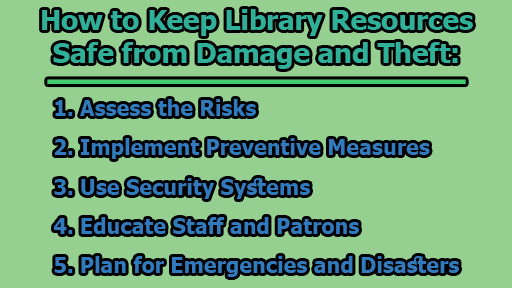How to Keep Library Resources Safe from Damage and Theft:
Protecting library materials from damage or theft is an essential task for libraries, which serve as valuable repositories of knowledge, culture, and education. Libraries play a crucial role in providing access to information for their communities and safeguarding their collections is paramount to ensure the continued availability of these resources. In this article, we will explore how to keep library resources safe from damage and theft.
1. Assess the Risks: The first step in protecting library materials is to assess the risks they face. Different types of materials may be vulnerable to various threats, including fire, water, pests, mold, sunlight, and vandalism. The library’s location, security measures, layout, and the behavior and needs of patrons should also be considered. By identifying potential sources of damage or theft, libraries can prioritize areas and items that require more attention and protection.
2. Implement Preventive Measures: To reduce the chances of damage or theft, libraries can implement preventive measures. These may include installing fire alarms, sprinklers, smoke detectors, and extinguishers to protect materials from fire. Controlling temperature and humidity levels using dehumidifiers, fans, and air conditioners can prevent mold and pest infestations. Using protective covers, cases, or boxes to store materials and avoiding placement near windows, radiators, or pipes can prevent fading, warping, or leaking.
3. Use Security Systems: Security systems can deter or detect damage or theft. Libraries can use locks, alarms, cameras, or sensors to secure doors, windows, and cabinets. Additionally, libraries can employ RFID (radio-frequency identification) tags, EM (electromagnetic) strips, or barcodes to label and track materials. RFID gates and detection systems are particularly effective at reducing theft or accidental removal of library items. RFID technology allows for efficient tracking, regardless of orientation or visibility.
4. Educate Staff and Patrons: A crucial step in protecting library materials is educating staff and patrons about the importance and value of these resources and the policies and procedures in place to protect them. Staff should be trained on proper handling, storage, and display of materials, as well as reporting and responding to incidents of damage or theft. Patrons should be informed about borrowing and usage rules, and the consequences of violating them. Promoting a culture of respect and responsibility is essential, and encouraging reporting of problems or suspicious activities helps maintain library security.
5. Plan for Emergencies and Disasters: Libraries should have plans in place for emergencies and disasters that can lead to severe damage or theft of materials. Creating an emergency response team, a disaster plan, and a recovery plan is vital. These plans should outline the roles, responsibilities, and actions that library staff will take in case of a fire, flood, earthquake, or other crisis. An emergency kit, contact list, and backup system containing essential supplies, information, and resources should be prepared. Regular review and updates of these plans and conducting drills and simulations are critical to improving preparedness.
In conclusion, protecting library materials from damage or theft is essential to maintain the integrity and availability of these valuable resources for the community. By assessing risks, implementing preventive measures, using security systems, educating staff and patrons, and planning for emergencies and disasters, libraries can ensure that their collections remain accessible and preserved for future generations. Safeguarding library materials is not just a duty; it is an investment in the intellectual and cultural wealth of society.

Former Student at Rajshahi University










